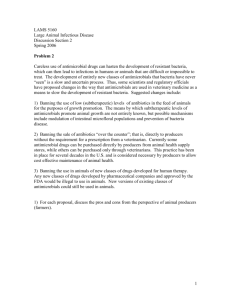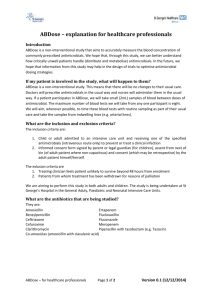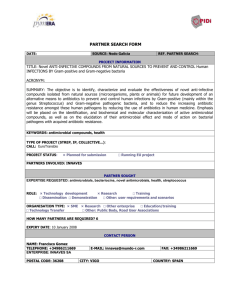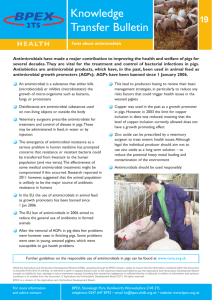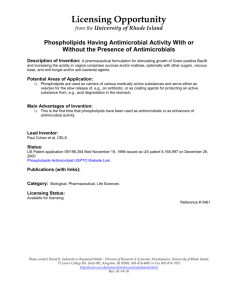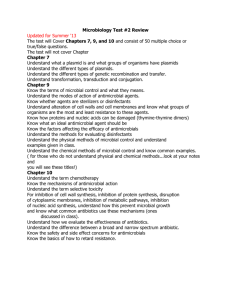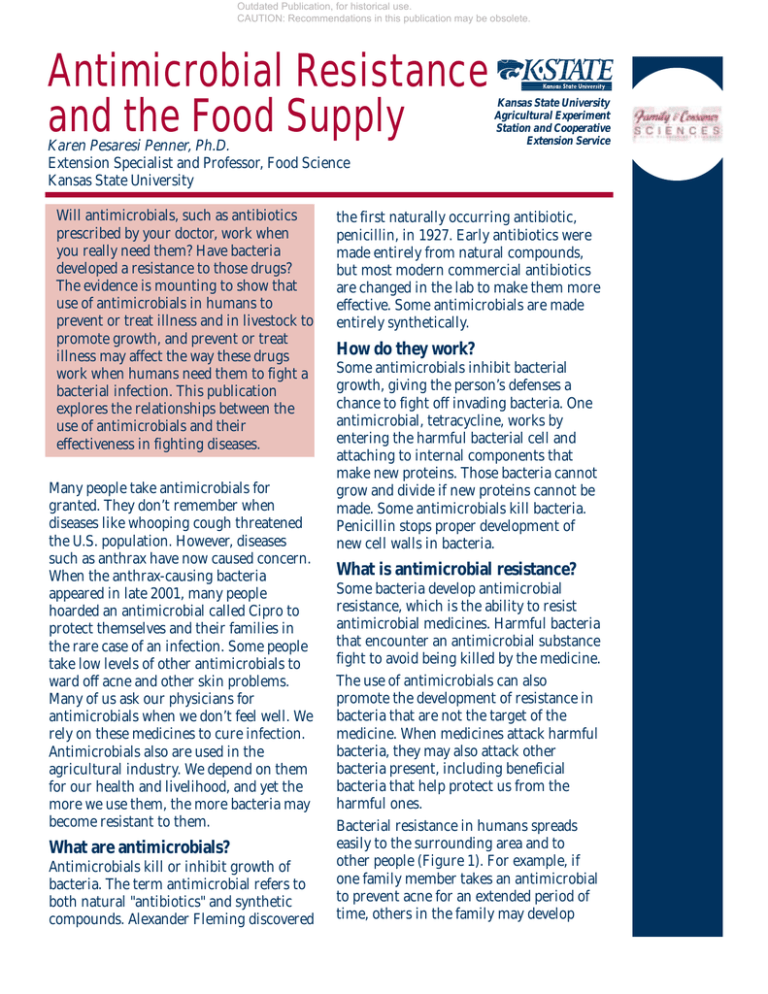
Outdated Publication, for historical use.
CAUTION: Recommendations in this publication may be obsolete.
Antimicrobial Resistance
and the Food Supply
Karen Pesaresi Penner, Ph.D.
Extension Specialist and Professor, Food Science
Kansas State University
Will antimicrobials, such as antibiotics
prescribed by your doctor, work when
you really need them? Have bacteria
developed a resistance to those drugs?
The evidence is mounting to show that
use of antimicrobials in humans to
prevent or treat illness and in livestock to
promote growth, and prevent or treat
illness may affect the way these drugs
work when humans need them to fight a
bacterial infection. This publication
explores the relationships between the
use of antimicrobials and their
effectiveness in fighting diseases.
Many people take antimicrobials for
granted. They don’t remember when
diseases like whooping cough threatened
the U.S. population. However, diseases
such as anthrax have now caused concern.
When the anthrax-causing bacteria
appeared in late 2001, many people
hoarded an antimicrobial called Cipro to
protect themselves and their families in
the rare case of an infection. Some people
take low levels of other antimicrobials to
ward off acne and other skin problems.
Many of us ask our physicians for
antimicrobials when we don’t feel well. We
rely on these medicines to cure infection.
Antimicrobials also are used in the
agricultural industry. We depend on them
for our health and livelihood, and yet the
more we use them, the more bacteria may
become resistant to them.
What are antimicrobials?
Antimicrobials kill or inhibit growth of
bacteria. The term antimicrobial refers to
both natural "antibiotics" and synthetic
compounds. Alexander Fleming discovered
Kansas State University
Agricultural Experiment
Station and Cooperative
Extension Service
the first naturally occurring antibiotic,
penicillin, in 1927. Early antibiotics were
made entirely from natural compounds,
but most modern commercial antibiotics
are changed in the lab to make them more
effective. Some antimicrobials are made
entirely synthetically.
How do they work?
Some antimicrobials inhibit bacterial
growth, giving the person’s defenses a
chance to fight off invading bacteria. One
antimicrobial, tetracycline, works by
entering the harmful bacterial cell and
attaching to internal components that
make new proteins. Those bacteria cannot
grow and divide if new proteins cannot be
made. Some antimicrobials kill bacteria.
Penicillin stops proper development of
new cell walls in bacteria.
What is antimicrobial resistance?
Some bacteria develop antimicrobial
resistance, which is the ability to resist
antimicrobial medicines. Harmful bacteria
that encounter an antimicrobial substance
fight to avoid being killed by the medicine.
The use of antimicrobials can also
promote the development of resistance in
bacteria that are not the target of the
medicine. When medicines attack harmful
bacteria, they may also attack other
bacteria present, including beneficial
bacteria that help protect us from the
harmful ones.
Bacterial resistance in humans spreads
easily to the surrounding area and to
other people (Figure 1). For example, if
one family member takes an antimicrobial
to prevent acne for an extended period of
time, others in the family may develop
Outdated Publication, for historical use.
CAUTION: Recommendations in this publication may be obsolete.
resistant bacteria on their skin. Heavy use
of antimicrobials in hospitals or on farms
results in increased levels of resistant
bacteria in people and animals not being
treated with the medicines. Travel can
spread antimicrobial resistance.
How does use affect the problem?
Antimicrobial use and misuse has spread
since the 1940s. In 1954, 2 million pounds
of antimicrobials were produced in the
United States. Today, that amount is more
than 50 million pounds. About 25 million
pounds are for human use, and about half
of that may be misuse. In the early 1990s, a
large number of antimicrobials were
prescribed for colds and upper respiratory
infections. Antimicrobials offer little relief
from such ailments. From 1992 through
2000, the overall prescription rate for these
drugs dropped by 25 percent, but the rates
for clarithromycin, quinolones and
amoxicillin increased significantly.
The appropriate use of antimicrobials is to
cure bacterial infections. These drugs are
not effective against viruses.
How is this a food safety issue?
foodborne pathogens than in the past. A
small number of antimicrobial-resistant
bacteria may make someone ill, but in the
past, it often took larger numbers of
bacteria to overcome the body’s normal
bacteria population.
The food supply also may be the source of
antimicrobial-resistant bacteria. Harmless
bacteria in food-producing animals can
become resistant to antimicrobials. These
resistant organisms may be transmitted to
humans in food. Once inside the human
gastrointestinal tract, these organisms may
pass their resistance to harmful bacteria.
What about agricultural use?
More than 40 percent of the antimicrobials
used in the United States are used in
animal production and other agricultural
enterprises. Drugs are used to treat
sickness or to prevent infection in animals.
For example, in chicken and turkey flocks,
antimicrobials may be mixed into feed or
water to prevent disease. The animals are
not treated individually, but as a flock.
Drugs are also used to treat mastitis and
respiratory diseases in cattle.
Antimicrobials called “antibiotic growth
promoters” are also used to promote
growth in animals. They are given in
subtherapeutic amounts in feed, often for
weeks or months. Long-term exposure to
drugs promotes animal growth, but the
amounts are too low to cure infection. This
regime provides a good opportunity for
bacteria in the animals to develop
The Food and Drug Administration has
been concerned about growing numbers of
drug-resistant human pathogens such as
Staphlyococcus aureus, Escherichia coli
O157:H7, various species of Campylobacter
and Salmonella, and Listeria
monocytogenes. These organisms are
known agents of foodborne illnesses.
Each year, millions of people get sick from
eating food contaminated
with bacteria such as
Salmonella. Infections in
those most likely to have
serious complications,
particularly the young and the
elderly, may be treated with
antimicrobials. Some
Salmonella and
Campylobacter species,
however, have become
resistant to these medicines.
Today, more people may
Figure 1. Use of antimicrobials in humans and animals.
actually become ill from
2
Outdated Publication, for historical use.
CAUTION: Recommendations in this publication may be obsolete.
resistance factors. Then, those resistant
bacteria pass to animal caretakers, the
immediate environment, people who handle and
prepare raw meats, and consumers who eat
undercooked or raw meats.
Antimicrobials are used in other
agricultural practices, too. They may be
applied as aerosol sprays to fruit trees to
prevent bacteria infection. Aerosols may
travel to other plants and animals and
encourage the development of resistant
bacteria. Resistant organisms may make
their way through the food chain via fruits
and vegetables to take up residence in the
intestinal tracts of human consumers.
Resistant pathogenic bacteria have been
isolated from many foodstuffs including
beef, pork, lamb, poultry, fish, shellfish,
alfalfa sprouts, bean sprouts, lettuce, apple
juice and other fruits and vegetables.
The runoff or discharge of farm wastes may
include antimicrobials that potentially lead
to a build-up of resistant organisms. Some
antimicrobials enter the water and soil this
way. Antimicrobial residues can be found in
some ponds and rivers, and in soils where
metabolites of these drugs may bind to
organic matter. Health effects of these
residues are unknown.
How is antimicrobial use in humans
different from use in animals?
Generally, in humans, antimicrobials are
used to treat illness. Occasionally, they are
used to prevent disease. Sick animals are
also given antimicrobials. Frequently,
however, whole flocks or herds are treated,
including animals that are not sick.
Antimicrobials are not given to humans to
promote growth, but this use is frequent in
animal agriculture.
What is the relationship between
animal drugs and human drugs?
The majority of drugs used in animals are
also those used to treat humans. These
antimicrobials include tetracyclines,
sulfonamides, penicillins, macrolides,
fluoroquinolones, cephalosporins,
aminoglycosides and streptogramins.
Key Terms to Know
Antibiotic - a chemical substance produced by a
microorganism that can kill or inhibit the growth of
another organism. One type of antimicrobial agent.
Antimicrobial - a substance that kills
microorganisms or suppresses their multiplication or
growth. May be naturally produced or made
synthetically. Includes antibiotics.
Antimicrobial resistance - the ability of
some organisms to resist or fight medicines that
should inhibit or kill the organisms.
Microorganism - microscopic organism
such as bacteria.
Subtherapeutic - an amount of a drug given
that is below the level needed to cure infection.
Virus - minute infectious agent without
independent metabolism, requiring living host cells.
How does the increase in
antimicrobial resistance affect
human health?
If an ill person is treated with a drug to
which the bacteria are resistant, the
medicine will not be effective. The illness
may last longer, be more severe or more
expensive to treat.
What is being done to slow
antimicrobial resistance?
Agriculture. Reduced antimicrobial use in
livestock and fruit production, along with
improved hygiene, may help decrease
resistant organisms in farm populations.
The American Veterinary Medical
Association has developed new guidelines
for drug use in animals.
Consumers. Appropriate human use of
prescription medicines is important. Use all
of the medicine for the entire time
designated. Do not save pills for another
time after you start to feel better. Your
infection may not be eliminated, and you
run the risk of allowing remaining
microorganisms to become even more
resistant and harder to eliminate.
• Do not demand antimicrobials for cold or
flu viruses. They are not effective.
3
Outdated Publication, for historical use.
CAUTION: Recommendations in this publication may be obsolete.
• Discard remainders of any old medicines.
Avoid self-treatment with unused drugs.
• Minimize use of antibacterial hand
cleansers and lotions.
• Wash hands and surfaces with soap and
water to prevent cross-contamination.
• Learn more about this health issue. Share
information with your family and friends.
Health Care. Physicians can attempt to
identify the cause of an illness before
prescribing antimicrobials. Selecting a
specific drug instead of a broad-spectrum
medicine can make a difference.
Hand washing after examining each patient
is important. Hospitals can separate
infected patients from others. Health
workers should be gloved and gowned.
Pharmaceutical Industry. The industry is
seeking new antimicrobials, but it takes
time to develop new medicines, complete
necessary testing and gain approvals.
Regulatory agencies. The U.S. Food and
Drug Administration and the U.S.
Department of Agriculture are working to
slow antimicrobial resistance. They have
established the National Antibiotic
Resistance Monitoring System to track
drug resistance and have developed
strategies to reduce development of
resistant organisms.
Greater awareness and action will stop the
rise of antimicrobial resistance. Our health
depends on it.
RESOURCES
The American Veterinary Medical Association.
Judicious therapeutic use of antimicrobials
www.avma.org/resources/
The Centers for Disease Control and Prevention
www.cdc.gov
The Centers for Disease Control and Prevention National Antibiotic Resistance Monitoring System
(NARMS)
www.cdc.gov/narms/
The U.S. Food and Drug Administration
www.fda.gov
Isaacson, R.E. and M.E. Torrence. The Role of
Antibiotics in Agriculture. The American Academy of
Microbiology. 2002
www.asm.org
Levy, S.B. The challenge of antibiotic resistance.
Scientific American. March 1998.
McCraig, L.F., Besser, R.E., and Hughes, J.M.
Antimicrobial drug prescriptions in ambulatory care
settings, United States, 1992-2000. Emerging
Infectious Diseases. 9(4):432-437, 2003.
Nawaz, M.S., Erickson, B.D., Khan, A.A., Khan, S.A.,
Pothuluri, J.V., Rafii, F., Sutherland, J.B., Wagner,
R.D., Cerniglia, C.E. Human health impact and
regulatory issues involving antimicrobial resistance
in the food animal production environment.
Regulatory Research Perspectives J., 1(1): 2001.
www.fda.gov/nctr/science/journals/text/
vol1iss1/rrp0701.htm
National Institute of Allergy and Infectious Diseases.
National Institutes of Health. Antimicrobial
resistance.
www.niaid.nih.gov/factsheets/antimicro.htm
U.S. Government Accounting Office. Food Safety:
The Agricultural Use of Antibiotics and Its
Implications for Human Health. GAO/RCED-99-74
www.gao.gov
This paper was reviewed by Larry Hollis, DVM, Beef Veterinarian and Mike Bradshaw, Ph.D., Wellness and Safety Specialist.
Brand names appearing in this publication are for product identification purposes only.
No endorsement is intended, nor is criticism implied of similar products not mentioned.
Publications from Kansas State University are available on the World Wide Web at: http://www.oznet.ksu.edu
Publications from Kansas State University may be freely reproduced for educational purposes. All other rights reserved.
In either case, credit Karen Pesaresi Penner, Antimicrobial Resistance and the Food Supply, August 2003.
Kansas State University Agricultural Experiment Station and Cooperative Extension Service , Manhattan, Kansas
MF-2593
August 2003
It is the policy of Kansas State University Agricultural Experiment Station and Cooperative Extension Service that all persons shall have equal opportunity and access to its
educational programs, services, activities, and materials without regard to race, color, religion, national origin, sex, age, or disability. Kansas State University is an equal
opportunity organization. These materials may be available in alternative formats.
Issued in furtherance of Cooperative Extension Work, Acts of May 8 and June 30, 1914, as amended. Kansas State University, County Extension Councils, Extension Districts,
and United States Department of Agriculture Cooperating, Marc A. Johnson, Director.
4

